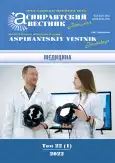Изучение морфолого-анатомических особенностей травы астрагала солодколистного
- Авторы: Позднякова Т.А.1, Бубенчиков Р.А.2
-
Учреждения:
- ФГБОУ ВО «Орловский государственный университет им. И.С. Тургенева» Минобрнауки России
- АО «Научно-производственное объединение «Микроген» Минздрава России
- Выпуск: Том 22, № 1 (2022)
- Страницы: 50-54
- Раздел: ФАРМАЦЕВТИЧЕСКАЯ ХИМИЯ, ФАРМАКОГНОЗИЯ
- URL: https://ogarev-online.ru/2410-3764/article/view/105209
- DOI: https://doi.org/10.55531/2072-2354.2022.22.1.50-54
- ID: 105209
Цитировать
Полный текст
Аннотация
Цель – установить морфолого-анатомические и микродиагностические признаки стебля, листовой пластинки, чашечки и венчика астрагала солодколистного в соответствии с современными требованиями нормативной документации.
Материал и методы. Объектом исследования служила трава астрагала солодколистного, заготовленная в Курской области в 2021 году в период массового цветения растения. Макро- и микроскопический анализ проводили в соответствии с требованиями ГФ РФ ХIV.
Результаты. Изучаемое сырье астрагала солодколистного состоит из неодревесневших облиственных стеблей длиной 20–25 см с цветками, цельных и измельченных листьев серовато-зеленого цвета, частей стебля и отдельных цветков зеленовато-желтого цвета. Микроскопический анализ позволил установить, что стебель астрагала солодколистного имеет округло-ребристую форму, снаружи покрыт эпидермисом c прямостенными клетками, с продольно-морщинистой кутикулой. Клетки листа со слабоизвилистыми стенками, устьица аномоцитного типа. Рахис на поперечном срезе имеет треугольную форму с небольшими латеральными выростами, устьица аномоцитного типа. Эпидермис рахиса опушен простыми двуклеточными волосками с бугристой поверхностью. Клетки эпидермиса чашечки от прозенхимной формы (в трубке чашечки) до паренхимной (в зеве, на зубцах чашечки), устьица аномоцитного типа. В основании венчика клетки эпидермиса прозенхимной формы, прямостенные с прямыми или со скошенными концами, в отгибе венчика клетки эпидермиса прозенхимной формы, прямостенные с продольной морщинистой кутикулой. Эпидермис стебля, листьев, рахиса и чашечки опушен простыми двуклеточными волосками на короткой базальной клетке с длинной конечной клеткой, с бугристой поверхностью.
Заключение. Установлены макро- и микродиагностические признаки травы астрагала солодколистного, позволяющие проводить диагностику сырья «Астрагала солодколистного трава».
Полный текст
Открыть статью на сайте журналаОб авторах
Татьяна Александровна Позднякова
ФГБОУ ВО «Орловский государственный университет им. И.С. Тургенева» Минобрнауки России
Автор, ответственный за переписку.
Email: pozdnyakova.tatyana.72@mail.ru
ORCID iD: 0000-0002-6058-6619
канд. фарм. наук, доцент, доцент кафедры фармакологии, клинической фармакологии и фармации
Россия, ОрелРоман Александрович Бубенчиков
АО «Научно-производственное объединение «Микроген» Минздрава России
Email: fg.ksmu@mail.ru
ORCID iD: 0000-0003-0955-6892
д-р фарм. наук, доцент, начальник отдела стандартизации и внедрения управления научных разработок, стандартизации и внедрения
Россия, МоскваСписок литературы
- Bratkov VM, Shkondrov АМ, Zdraveva PK, et al. Flavonoids from the Genus Astragalus: Phytochemistry and Biological Activity. Pharmacognosy Reviews. 2016;10:19:11-32. doi.org/10.4103/0973-7847.176550
- Berezutsky MA, Yakubova LR, Durnova NA, et al. Pharmacological properties of drugs created on the basis of Astragal extract (Review). Chemical Pharmaceutical Journal. 2020;54:4:20-25. (In Russ.). [Березуцкий М.А., Якубова Л.Р., Дурнова Н.А., и др. Фармакологические свойства препаратов, созданных на основе экстракта астрагала (Обзор). Химико-фармацевтический журнал. 2020;54:4:20-25]. doi: 10.30906/0023-1134-2020-54-4-20-25
- Ilyina TA. Big illustrated encyclopedia of medicinal plants. M., 2015. (In Russ.). [Ильина Т.А. Большая иллюстрированная энциклопедия лекарственных растений. М., 2015].
- Sergalieva MU, Mazhitova MV, Samotrueva MA. Biological activity of plant extracts of the genus Astragalus. Modern problems of science and education. 2015;5:648. (In Russ.). [Сергалиева М.У., Мажитова М.В., Самотруева М.А. Биологическая активность растений рода Astragalus. Современные проблемы науки и образования. 2015;5:648].
- Sergalieva MU, Mazhitova MV, Samotrueva MA. Plants of the genus Astragalus: prospects for application in pharmacy. Astrakhan Medical Journal. 2015;10(2):17-31. (In Russ.). [Сергалиева М.У., Мажитова М.В., Самотруева М.А. Растения рода астрагал: перспективы применения в фармации. Астраханский медицинский журнал. 2015;10(2):17-31].
- Chen В, Li R, Yan N, et al. Astragaloside IV controls collagen reduction in photoaging skin by improving transforming growth factor-β/Smad signaling suppression and inhibiting matrix metalloproteinase-1. Molecular Medicine Reports. 2015;11:5:3344-3348. doi.org/10.3892/mmr.2015.3212
- Xia L, Guo D, Chen B. Neuroprotective effects of astragaloside IV on Parkinson disease models of mice and primary astrocytes. Exp Ther Med. 2017;14(6):5569-5575. doi: 10.3892/etm.2017.5238
- Yang WT, Zheng XW, Chen S, et al. Chinese herbal medicine for Alzheimer's disease: Clinical evidence and possible mechanism of neurogenesis. Biochem Pharmacol. 2017;141:143-155. doi: 10.1016/j.bcp.2017.07.002
- Wen W, Chen J, Ding L, et al. Astragaloside exerts anti-photoaging effects in UVB-induced premature senescence of rat dermal fibroblasts through enhanced autophagy. Arch Biochem Biophys. 2018;1:657:31-40. doi: 10.1016/j.abb.2018.09.007
- Shen CY, Jiang JG, Yang L, et al. Anti-ageing active ingredients from herbs and nutraceuticals used in traditional Chinese medicine: pharmacological mechanisms and implications for drug discovery. Brit J Pharmacol. 2017;174:11:1395-1425. doi: 10.1111/bph.13631
- Pharmacopoeia article FS 42-533-72 "Astragalus dasyаnthus herb", approved. 13.12.1972:3. (In Russ.). [Фармакопейная статья ФС 42-533-72 «Трава астрагала шерстистоцветкового», утв. 13.12.1972:3].
- Budantsev AL. Plant resources of Russia: Wild flowering plants, their composition and biological activity. Vol.3. Fabaceae-Apiaceae families. M., 2010. (In Russ.). [Буданцев А.Л. Растительные ресурсы России: Дикорастущие цветковые растения, их компонентный состав и биологическая активность. Т.3. Семейства Fabaceae-Apiaceae. М., 2010].
- Mayevsky PF. Flora of the middle zone of the European part of Russia. M., 2014. (In Russ.). [Маевский П.Ф. Флора средней полосы европейской части России. М., 2014].
- Pozdnyakova TA, Bubenchikov RA. The study of antioxidant activity of the herb Astragalus glycyphyllus L. Aspirantskiy vestnik Povolzhiya. 2019;1-2:27-32. (In Russ.). [Позднякова Т.А., Бубенчиков Р.А. Изучение антиоксидантной активности травы астрагала солодколистного. Аспирантский вестник Поволжья. 2019;1-2:27-32]. doi: https://doi.org/10.17816/2072-2354.2019.19.1.27-32
- Pozdnyakova TA, Bubenchikov RA. Fatty and organic acids of the Astragalus glycyphyllus. Perm Medical Journal. 2017;34:1:90-94. (In Russ.). [Позднякова Т.А., Бубенчиков Р.А. Жирные и органические кислоты астрагала солодколистного (Astragalus glycyphyllus L.). Пермский медицинский журнал. 2017;34:1:90-94]. doi: 10.17816/pmj34190-94
- State Pharmacopoeia 14 edition. Electronic edition. 2018. URL: http://femb.ru/femb/pharmacopea.php (08 January 2022). [Государственная фармакопея РФ 14 издание. 2018. URL: http://femb.ru/femb/pharmacopea.php (08 Января 2022)].
- Pozdnyakova TA, Bubenchikov RA, Kondratova YuA. Morphological and anatomical study of the herb of Astargalus dasyаnthus. Pharmacy. 2018;67:3:30-34. (In Russ.). [Позднякова Т.А., Бубенчиков Р.А., Кондратова Ю.А. Морфолого-анатомическое изучение травы астаргала шерстистоцветкового. Фармация. 2018;67:3:30-34]. doi: 10.29296/25419218-2018-03-06
Дополнительные файлы










